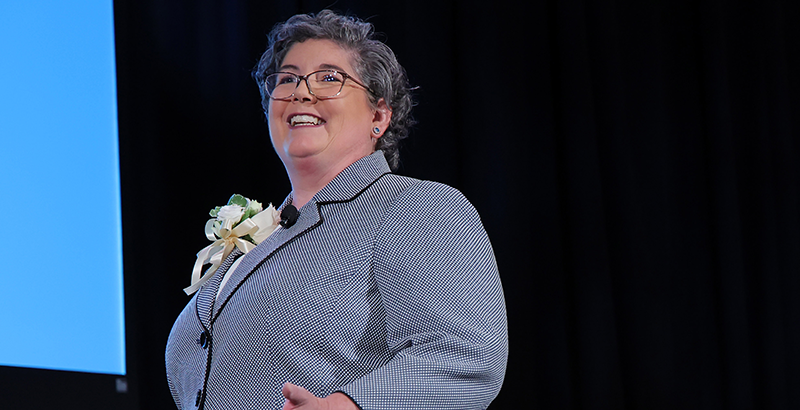
"As a clinician, researcher, and consumer of physical therapist services, I'm extremely concerned about the gap between knowledge development and implementation in health care," Stacey Dusing, PT, PhD, FAPTA, said in opening the 28th John H.P. Maley Lecture.
Titled "Igniting the Fire of Discovery: Creating Partnerships Between Research, Education, and Practice," the lecture was presented July 23 as part of the APTA Leadership Congress in Washington, D.C. Dusing used the platform to highlight the crucial need for translating research findings into practical clinical applications within the physical therapy profession.
A board-certified clinical specialist in pediatric physical therapy, Dusing is the Sykes Family Chair of Pediatric Physical Therapy, Health and Development, a tenured associate professor, and director of pediatric research in the Division of Biokinesiology and Physical Therapy at the University of Southern California. She also directs the university's Motor Development Laboratory. In addition, Dusing is a three-time funding recipient of the Foundation for Physical Therapy Research and the recipient of a 2005 Promotion of Doctoral Studies I Scholarship.
No one would debate that producing high-quality research evidence to support physical therapy is important, Dusing said. However, as a clinical trials researcher, Dusing said she is "terrified by the perspective that only one in five evidence-based interventions ever sees practice by a consumer of health care." And as a caregiver, she is "frightened by the statistic that only 20%-50% of what's provided in any health care setting is actually evidence-based."
The Role of Research Training
To address the chasm between research and the patient, Dusing said the profession needs to take "a big hard look at how we're training our professionals" — both DPT and PhD students. "I would challenge us to think outside of just how we're preparing our professionals to provide services in physical therapist practice and to look at the research areas," she said.
In describing the workload of a typical academic professional, Dusing pointed to three pillars: teaching, scholarship, and service. A more balanced approach is needed between them, she said, as the vast majority of their time is spent teaching, with 20% spent in each of scholarship and service. But the more alarming statistic she called to attention is that only 5%-7% of faculty are practicing clinically.
"If we're looking for knowledge translation to happen, who do we expect to be translating that knowledge?" Dusing asked. She emphasized the importance of defining faculty roles, both in clinics and academia, to ensure that faculty and clinicians have opportunities to engage in research and knowledge translation.
The ideal outcome of successful academic training is the clinician scientist, which Dusing defined as a qualified health professional from any health discipline who functions mainly as a career scientist who is also dedicated to clinical practice and education. Despite what Dusing said were a lack of formal training for someone to become a clinician scientist and a lack of needed support for such a position within faculty or in academic hospitals, a survey asking health care providers about the impact of having a clinician scientist embedded in their practice yielded positive responses. On the downside, the cost of employing a clinician scientist was identified as an obstacle, as someone in that position would not be 100% revenue-generating. Similar responses came from the academic side: The person's unique training and background were seen as valuable, but having a clinician scientist on faculty was a cost challenge because they cannot take on a full-time teaching load.
Cost to the program is not the only barrier to research training, Dusing noted. The cost to degree candidates also can be prohibitive, and those who are the most in debt — largely from student loans — may have the hardest time transitioning into a PhD program, she said.
So how does the profession increase the number of clinician scientists in the physical therapy workforce? Dusing proposed four action items:
- Expand the number of clinician scientist training programs in the same locations as discovery-based research programs to promote cross-pollination between clinical and research perspectives.
- Advocate for funding models that integrate research and clinical practices and reach out to internal and external funding agencies for their support.
- Intentionally design clinical research training programs to include exposure to the clinical environment.
- Increase the demand for clinician scientists through collaboration with partnerships between health care systems and research training programs.
In addition to these calls to action, Dusing said she believes the day-to-day communication between clinicians and researchers would be what makes the biggest change. "That day-to-day communication tends to answer the best questions and ask the best questions, but we only have that if we have players in the room who have different viewpoints."
Dusing concluded the lecture by challenging the audience: "Are you interested in changing the course of history by bringing research and practice together to improve knowledge translation, improve our educational system, and ensure that we have faculty and research with which to demonstrate both our efficacy as a profession but also to continue to grow as a profession?"